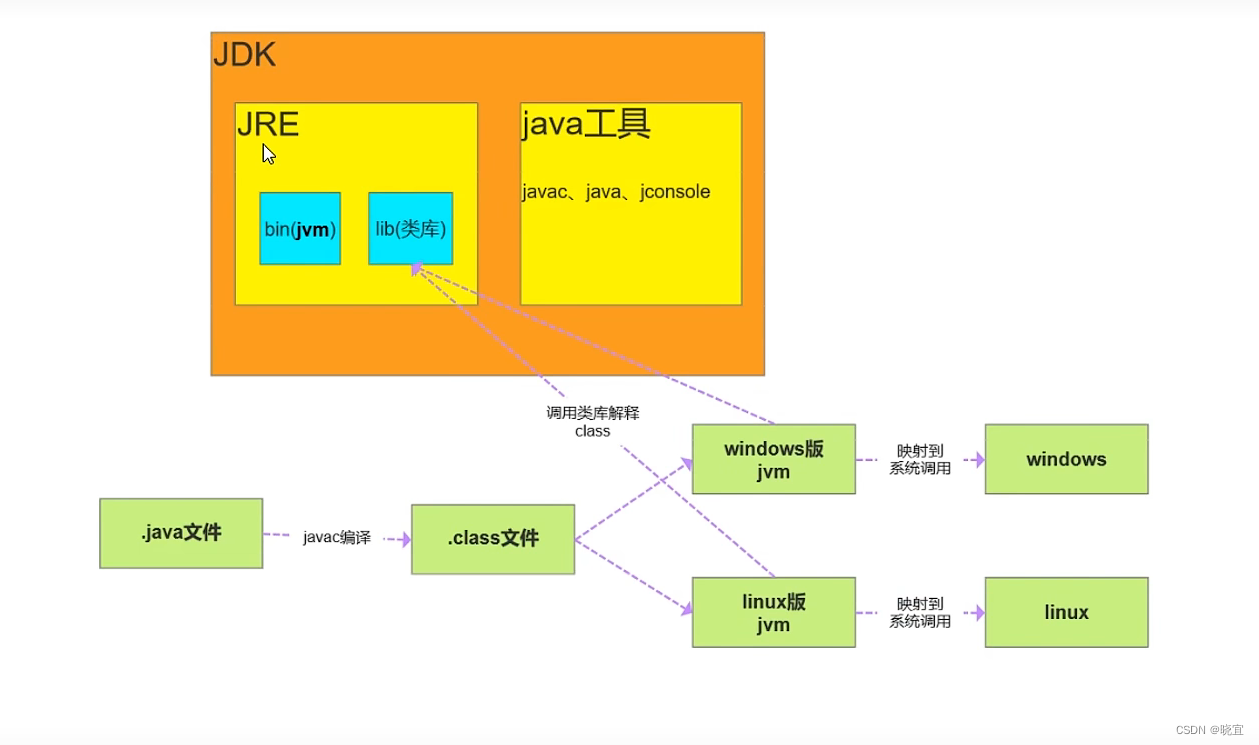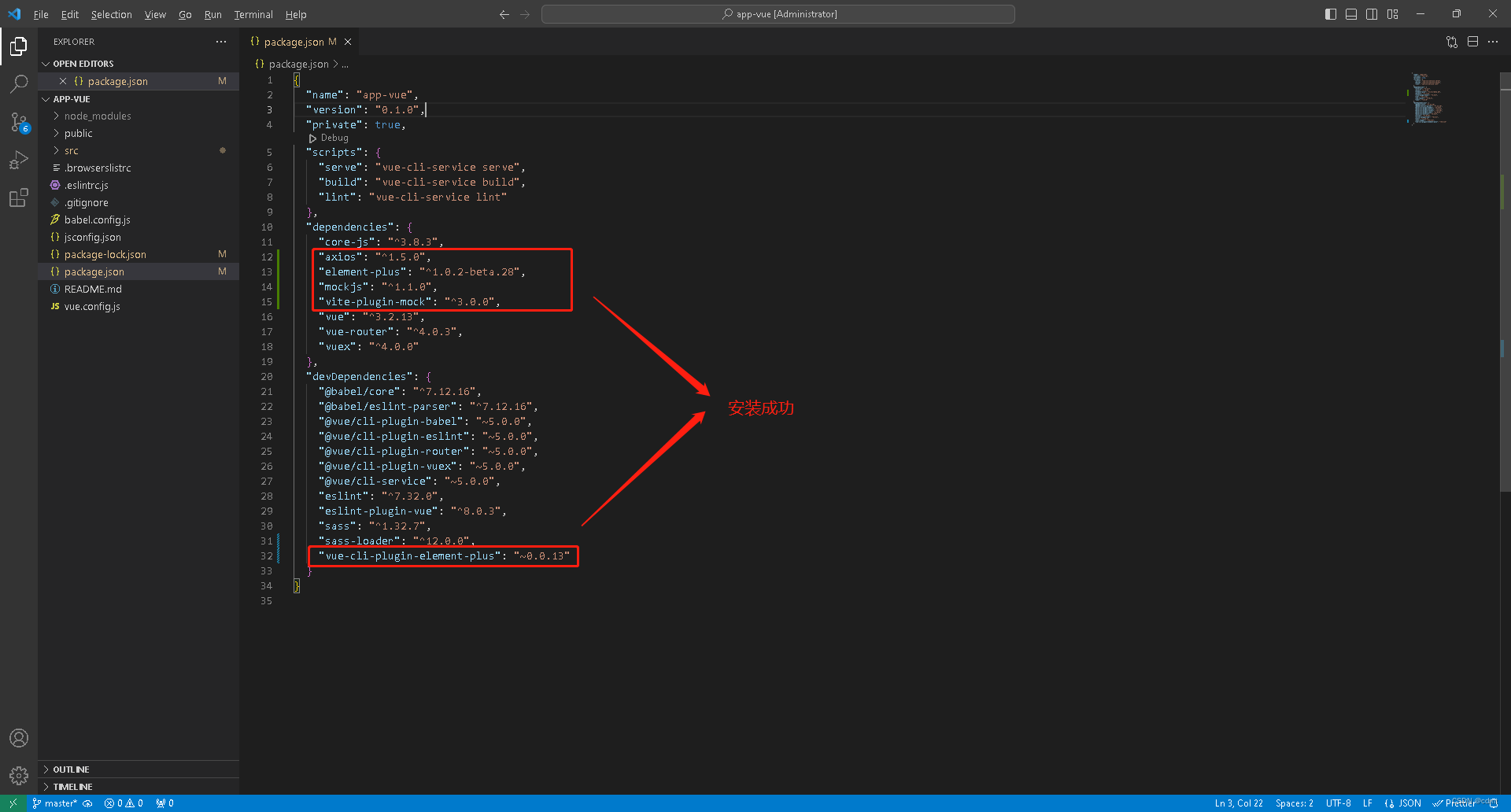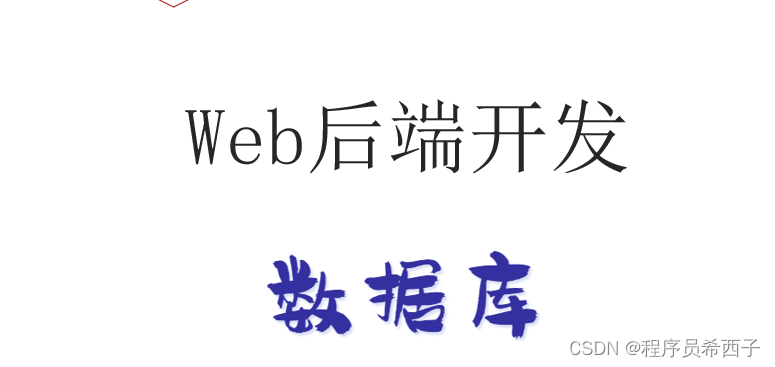
一.多表查询

-- ================================多表查询: 数据准备=====================================
-- 部门管理
create table tb_dept(
id int unsigned primary key auto_increment comment '主键ID',
name varchar(10) not null unique comment '部门名称',
create_time datetime not null comment '创建时间',
update_time datetime not null comment '修改时间'
) comment '部门表';
insert into tb_dept (id, name, create_time, update_time) values(1,'学工部',now(),now()),(2,'教研部',now(),now()),(3,'咨询部',now(),now()), (4,'就业部',now(),now()),(5,'人事部',now(),now());
-- 员工管理
create table tb_emp (
id int unsigned primary key auto_increment comment 'ID',
username varchar(20) not null unique comment '用户名',
password varchar(32) default '123456' comment '密码',
name varchar(10) not null comment '姓名',
gender tinyint unsigned not null comment '性别, 说明: 1 男, 2 女',
image varchar(300) comment '图像',
job tinyint unsigned comment '职位, 说明: 1 班主任,2 讲师, 3 学工主管, 4 教研主管, 5 咨询师',
entrydate date comment '入职时间',
dept_id int unsigned comment '部门ID',
create_time datetime not null comment '创建时间',
update_time datetime not null comment '修改时间'
) comment '员工表';
INSERT INTO tb_emp
(id, username, password, name, gender, image, job, entrydate,dept_id, create_time, update_time) VALUES
(1,'jinyong','123456','金庸',1,'1.jpg',4,'2000-01-01',2,now(),now()),
(2,'zhangwuji','123456','张无忌',1,'2.jpg',2,'2015-01-01',2,now(),now()),
(3,'yangxiao','123456','杨逍',1,'3.jpg',2,'2008-05-01',2,now(),now()),
(4,'weiyixiao','123456','韦一笑',1,'4.jpg',2,'2007-01-01',2,now(),now()),
(5,'changyuchun','123456','常遇春',1,'5.jpg',2,'2012-12-05',2,now(),now()),
(6,'xiaozhao','123456','小昭',2,'6.jpg',3,'2013-09-05',1,now(),now()),
(7,'jixiaofu','123456','纪晓芙',2,'7.jpg',1,'2005-08-01',1,now(),now()),
(8,'zhouzhiruo','123456','周芷若',2,'8.jpg',1,'2014-11-09',1,now(),now()),
(9,'dingminjun','123456','丁敏君',2,'9.jpg',1,'2011-03-11',1,now(),now()),
(10,'zhaomin','123456','赵敏',2,'10.jpg',1,'2013-09-05',1,now(),now()),
(11,'luzhangke','123456','鹿杖客',1,'11.jpg',5,'2007-02-01',3,now(),now()),
(12,'hebiweng','123456','鹤笔翁',1,'12.jpg',5,'2008-08-18',3,now(),now()),
(13,'fangdongbai','123456','方东白',1,'13.jpg',5,'2012-11-01',3,now(),now()),
(14,'zhangsanfeng','123456','张三丰',1,'14.jpg',2,'2002-08-01',2,now(),now()),
(15,'yulianzhou','123456','俞莲舟',1,'15.jpg',2,'2011-05-01',2,now(),now()),
(16,'songyuanqiao','123456','宋远桥',1,'16.jpg',2,'2007-01-01',2,now(),now()),
(17,'chenyouliang','123456','陈友谅',1,'17.jpg',NULL,'2015-03-21',NULL,now(),now());



消除了无效的笛卡尔积

1.内连接

-- =======================内连接=====================
-- A.查询员工的姓名,及所属的部门名称(隐式内连接)
select tb_emp.name '姓名', tb_dept.name '所属部门' from tb_emp, tb_dept where tb_emp.dept_id = tb_dept.id;
-- 起别名
select e.name '姓名', d.name '所属部门' from tb_emp e, tb_dept d where e.dept_id = d.id;
-- B.查询员工的姓名,及所属的部门名称(显式内连接)
select tb_emp.name '姓名', tb_dept.name '所属部门' from tb_emp join tb_dept on tb_emp.dept_id = tb_dept.id;
-- 起别名
select e.name '姓名', d.name '所属部门' from tb_emp e join tb_dept d on e.dept_id = d.id; 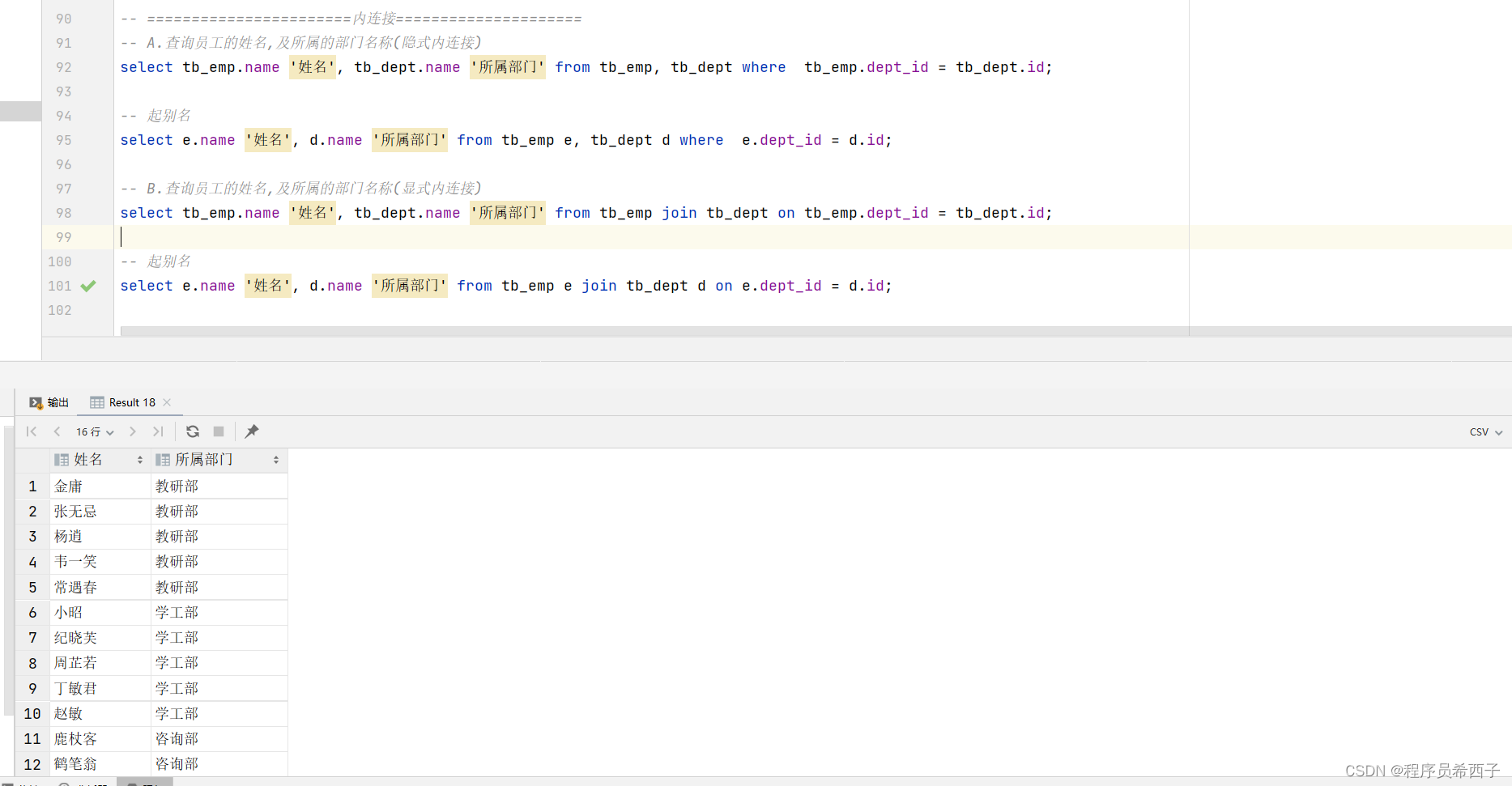
2.外连接

-- =======================外连接=====================
-- A.查询所有员工的姓名,及所属的部门名称(左外连接) -- 左边的表所有值列出来(包含null)
select e.name, d.name from tb_emp e left join tb_dept d on e.dept_id = d.id;
-- =
select e.name, d.name from tb_dept d right join tb_emp e on e.dept_id = d.id;
-- B.查询所有员工的姓名,及所属的部门名称(右外连接) -- 右边的表所有值列出来(包含null)
select e.name, d.name from tb_emp e right join tb_dept d on e.dept_id = d.id;
-- =
select e.name, d.name from tb_dept d left join tb_emp e on e.dept_id = d.id;3.子查询
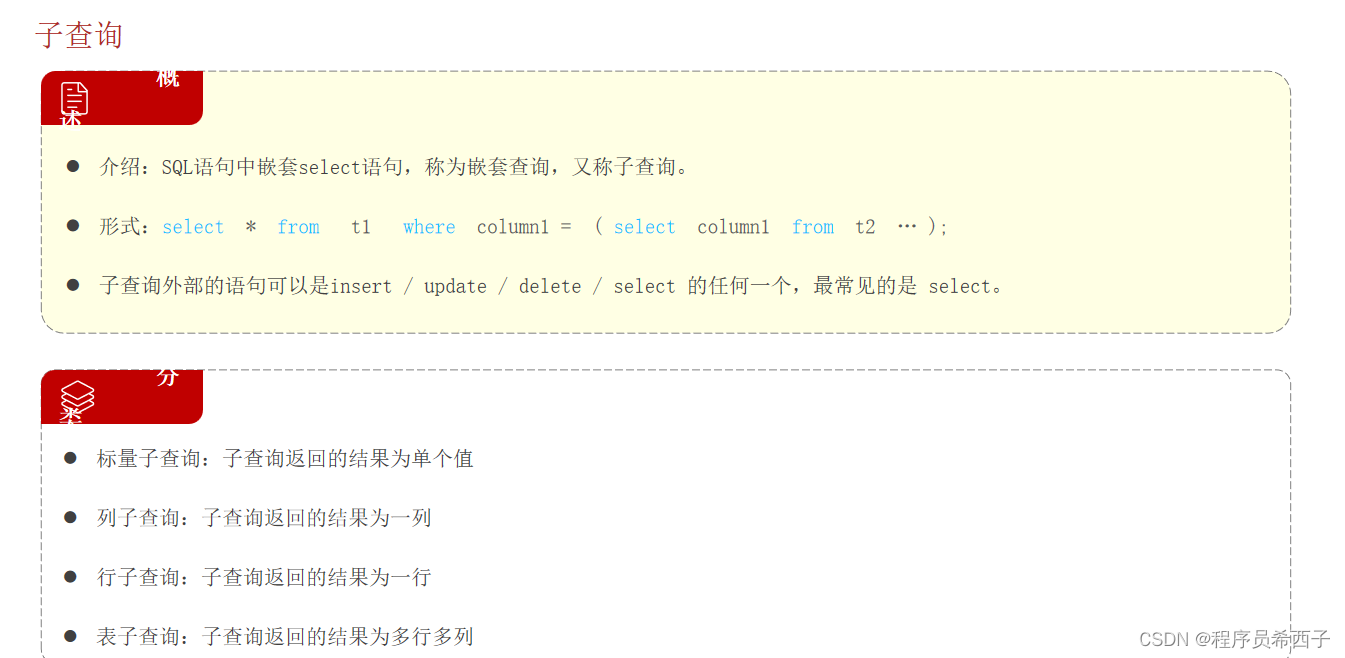

-- =======================子查询=========================
-- 标量子查询
-- A.查询 "教研部" 所有员工信息
-- a.查询 教研部 的部门id
select id from tb_dept where name = '教研部';
-- b.在查询该部门id下的所以员工信息
select * from tb_emp where dept_id = 2;
-- 合并
select * from tb_emp where dept_id = (select id from tb_dept where name = '教研部');
-- B.查询在 "方东白" 入职之后的员工信息
-- a.查询方东白的入职信息
select entrydate from tb_emp where name = '方东白';
-- b.查询在方东白入职之后的员工信息
select * from tb_emp where entrydate > '2012-11-01';
-- 合并
select * from tb_emp where entrydate > (select entrydate from tb_emp where name = '方东白');-- 列子查询
-- A.查询 "教研部" 和 "咨询部" 的所有员工信息
-- a.查询 "教研部" 和 "咨询部" 的部门id
select id from tb_dept where name = '教研部' or name = '咨询部';
-- b.根据部门id,查询该部门下的员工信息
select * from tb_emp where dept_id in (3,2);
-- 合并
select * from tb_emp where dept_id in (select id from tb_dept where name = '教研部' or name = '咨询部');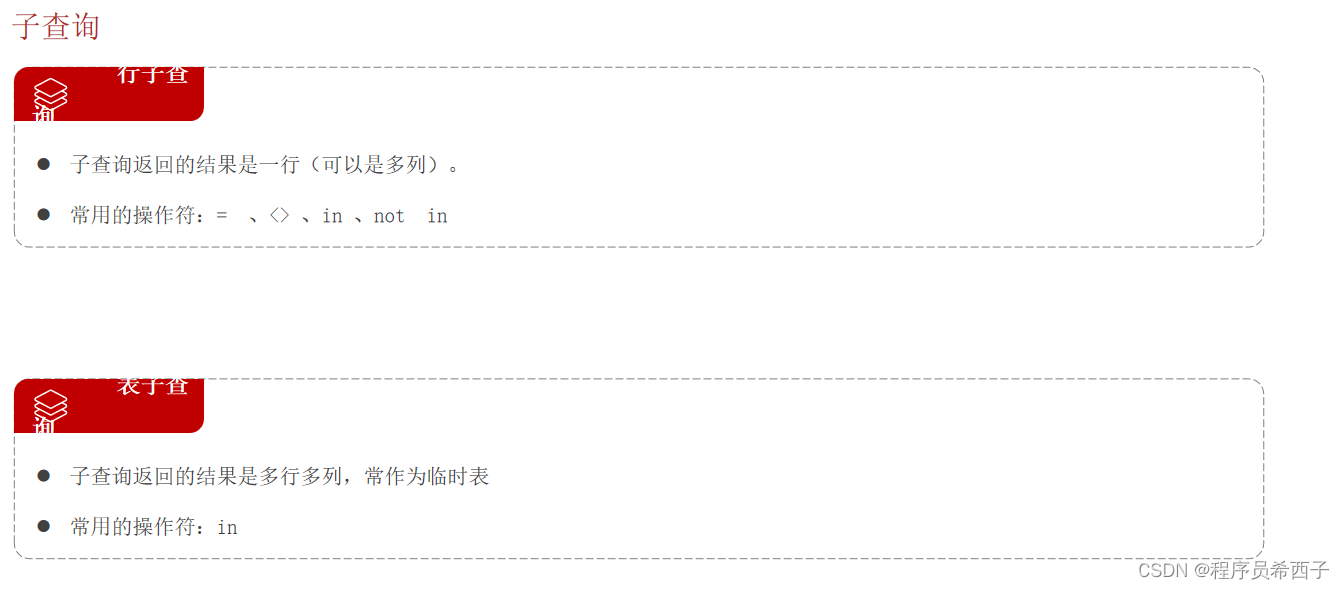
-- 行子查询
-- A. 查询与 "韦一笑" 的入职日期 及 职位相同的员工信息
-- a.查询 韦一笑的入职日期和职位
select entrydate,job from tb_emp where name = '韦一笑';
-- b.查询与其入职日期和职位相同的员工信息
select * from tb_emp where entrydate = '2007-01-01' and job = 2;
-- 合并
select * from tb_emp where (entrydate,job) in (select entrydate,job from tb_emp where name = '韦一笑');
-- 表子查询
-- A.查询入职日期是"2006-01-01"之后的员工信息, 及其部门名称
-- a.查询入职入职日期是2006-01-01之后的员工信息
select * from tb_emp where entrydate > '2006-01-01';
-- b.查询这部分员工信息的部门名称
select d.name,e.* from (select * from tb_emp where entrydate > '2006-01-01') e, tb_dept d where e.dept_id = d.id;
4.案例


-- 需求:
# 1.查询价格低于 10元 的菜品的名称 、价格 及其 菜品的分类名称
-- a.
# select name,price from dish d where price < 10;
# select c.name,d.price,d.name from (select * from dish where price < 10) d, category c where c.id = d.category_id;
select c.name,d.price,d.name from category c, dish d where c.id = d.category_id and d.price < 10;
# 2.查询所有价格在 10元(含)到50元(含)之间 且 状态为"起售"的菜品名称、价格及其分类名称 (即使菜品没有分类 , 也要将菜品查询出来)
# select name,price from dish where price between 10 and 50 and status = 1;
-- select d.name,d.price,c.name from (select * from dish where price between 10 and 50 and status = 1) d left join category c on c.id = d.category_id;
select d.name, d.price, c.name
from dish d
left join category c on d.category_id = c.id
where d.price between 10 and 50
and d.status = 1;
# 3.查询每个分类下最贵的菜品, 展示出分类的名称、最贵的菜品的价格
select category_id,max(price) price from dish group by category_id;
# select c.name, d.price
# from (select category_id, max(price) price from dish group by category_id) d,
# category c
# where c.id = d.category_id;
select c.name,max(d.price) from category c, dish d where c.id = d.category_id group by c.name;
# 4.查询各个分类下 菜品状态为 "起售" , 并且 该分类下菜品总数量大于等于3 的 分类名称
-- select category_id,count(category_id) from dish group by category_id;
-- select category_id,count(category_id) count from dish group by category_id having count(category_id)>=3;
-- select c.name,d.count from category c, (select category_id,count(category_id) count from dish group by category_id having count(category_id)>=3) d where c.id = d.category_id;
select c.name, count(*)
from category c,
dish d
where c.id = d.category_id
and d.status = 1
group by c.name
having count(*) >= 3;
# 5.查询出 "商务套餐A" 中包含了哪些菜品 (展示出套餐名称、价格, 包含的菜品名称、价格、份数)
# select id, name, price from setmeal where name = '商务套餐A';
#
# select s.name,s.price from (select id, name, price from setmeal where name = '商务套餐A') s, setmeal_dish ssd where s.id = ssd.setmeal_id;
#
# select name, price from dish;
# select d.name,d.price from dish d, setmeal_dish dsd where d.id = dsd.dish_id;
#
# select * from setmeal_dish;
# select price from dish group by count(price);
-- 表: setmeal, dish, setmeal_dish
-- SQL:
select s.name, s.price, d.name, d.price, sd.copies
from setmeal s,
dish d,
setmeal_dish sd
where s.id = sd.setmeal_id
and d.id = sd.dish_id
and s.name = '商务套餐A';
# 6.查询出低于菜品平均价格的菜品信息 (展示出菜品名称、菜品价格)
-- select avg(price) from dish;
select name, price from dish where price <= (select avg(price) from dish);

二.事务
1.介绍 & 操作

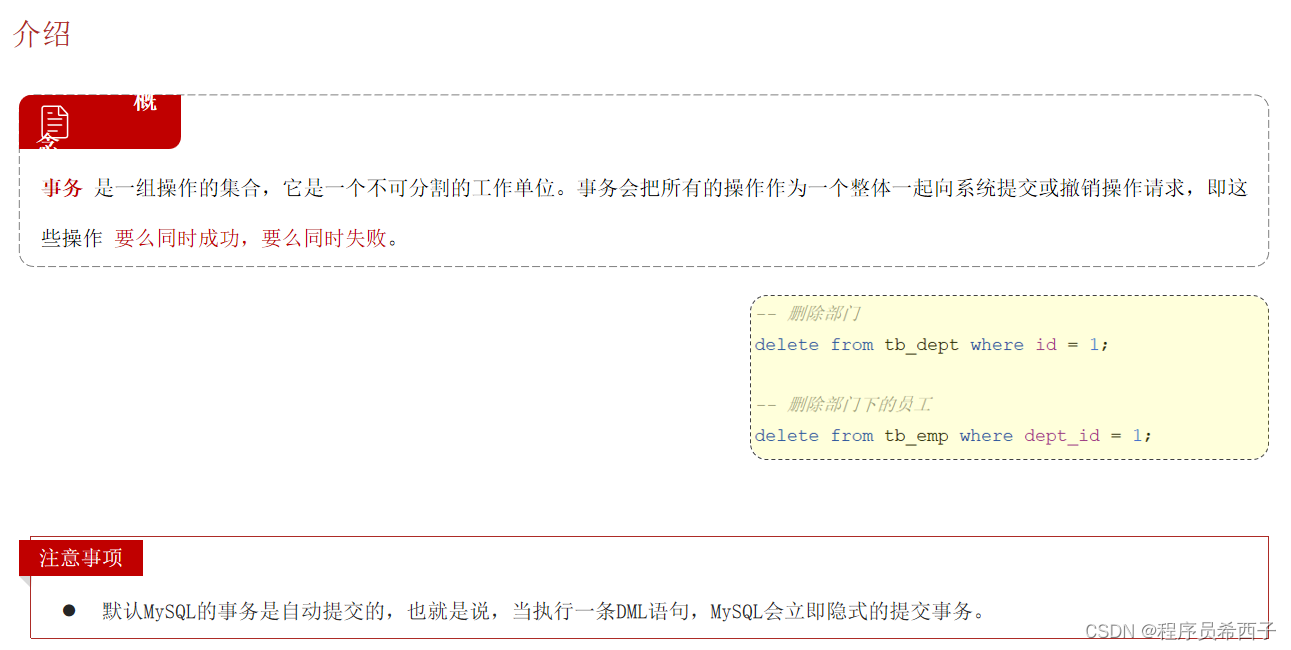
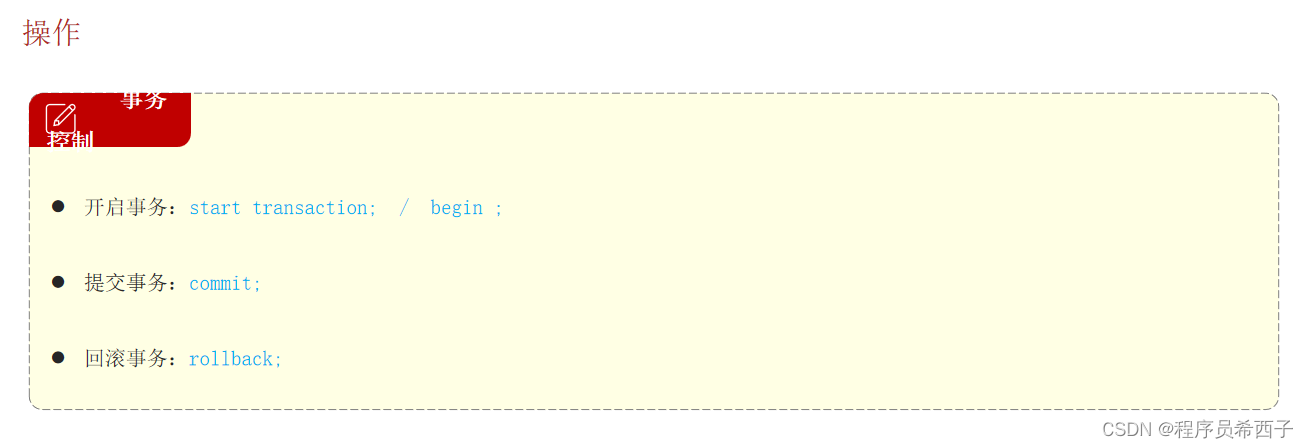
2.四大特性


三.索引
1.介绍

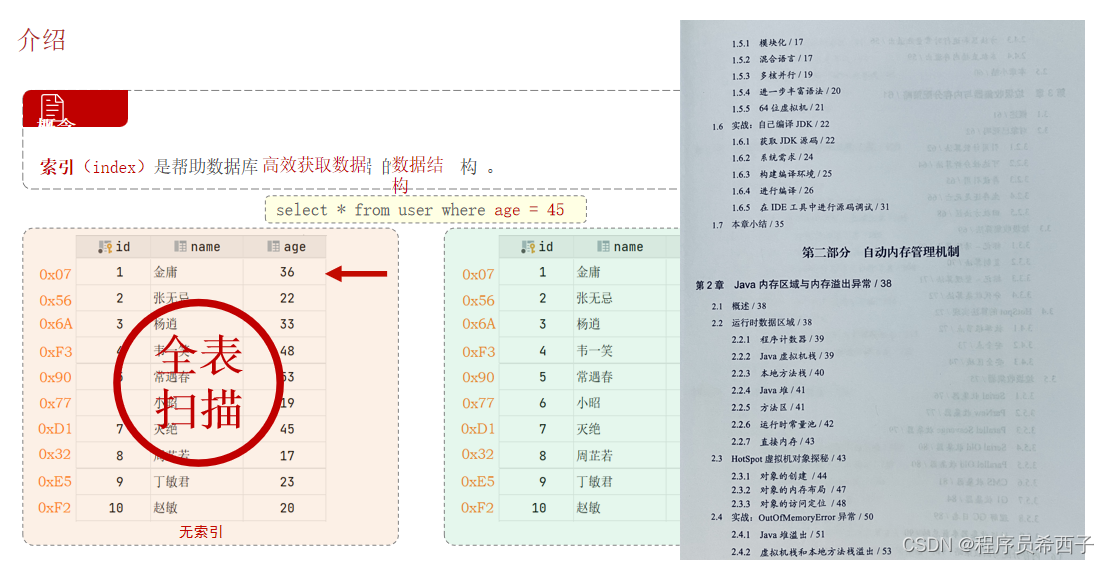
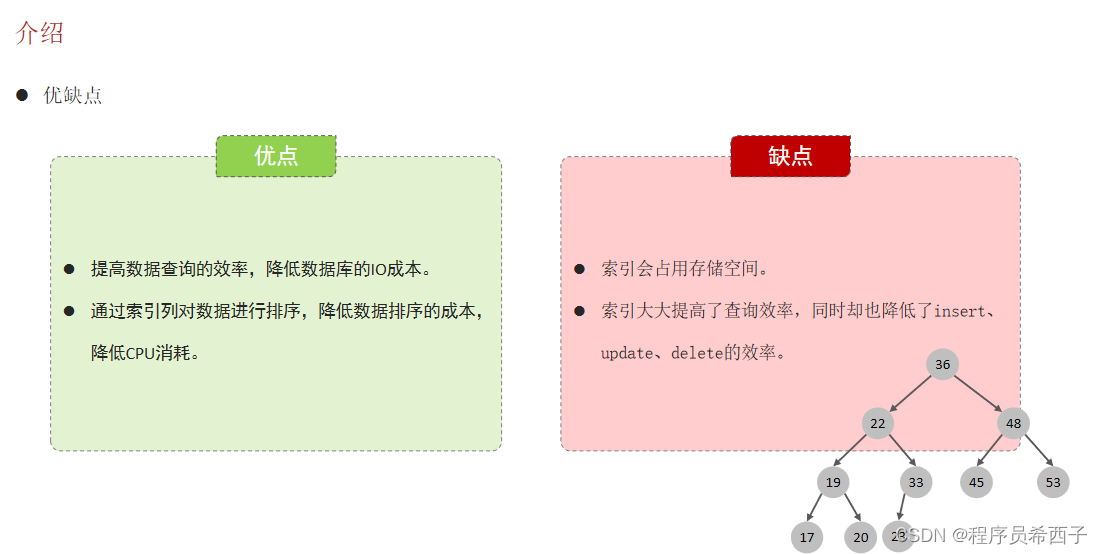
2.结构
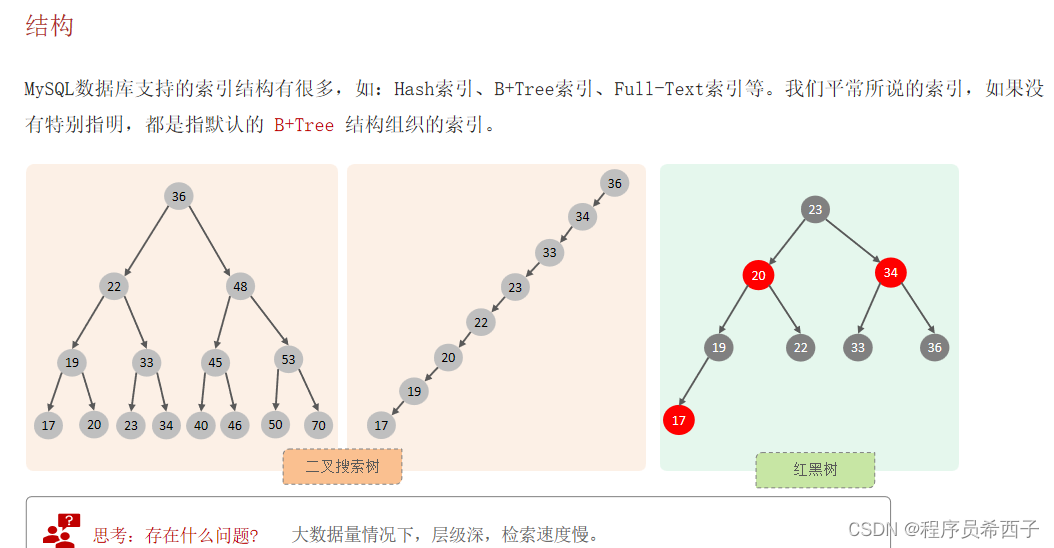

3.语法

-- =====================索引=====================
-- 创建: 为tb_emp表的name字段建立一个索引
create index idx_tb_emp on tb_emp(name);
-- 查询: 查询tb_emp 表的索引信息
show index from tb_emp;
-- 删除: 删除tb_emp 表中name字段的索引
drop index idx_tb_emp on tb_emp; 
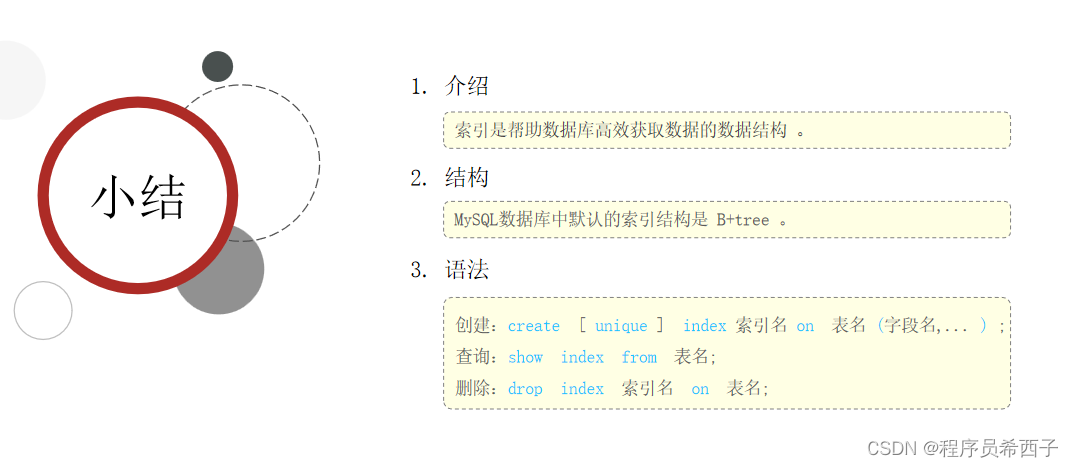
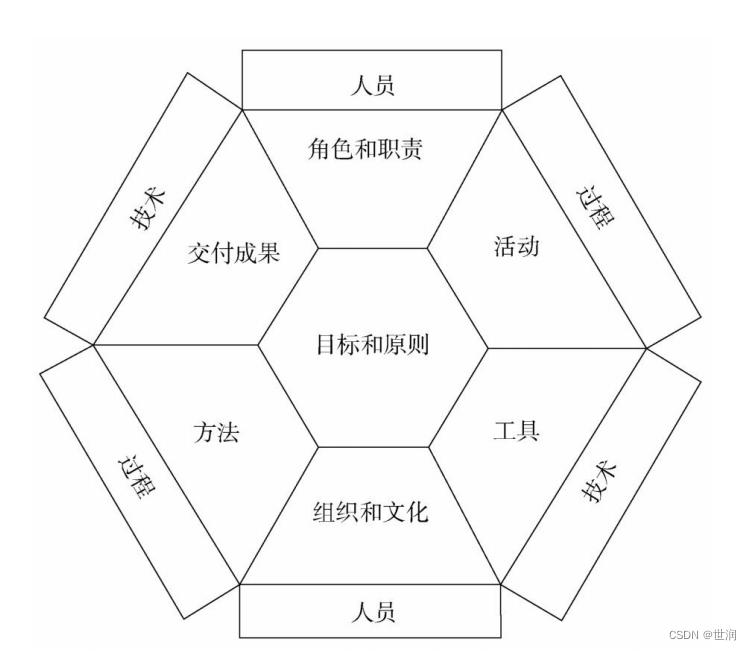
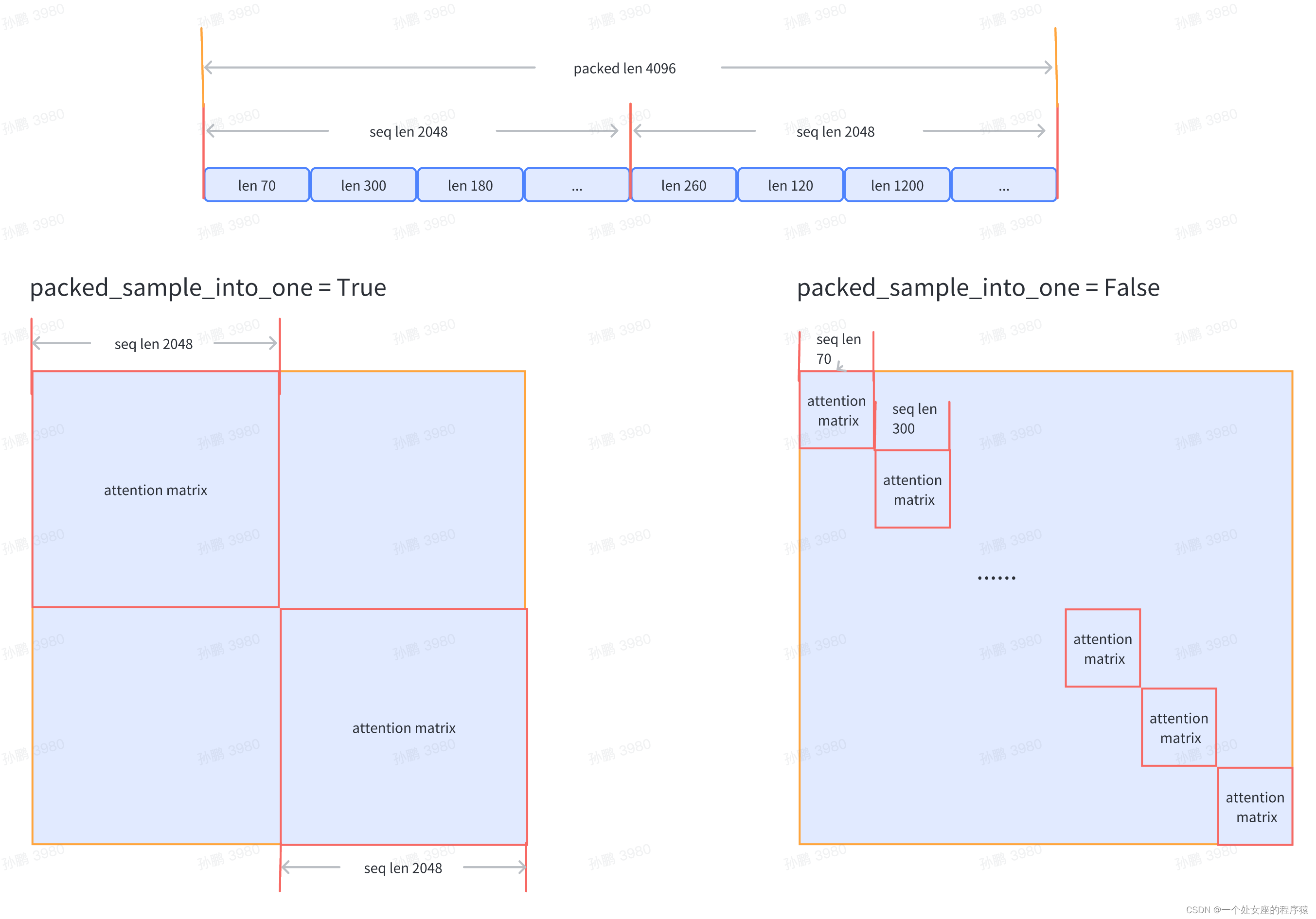





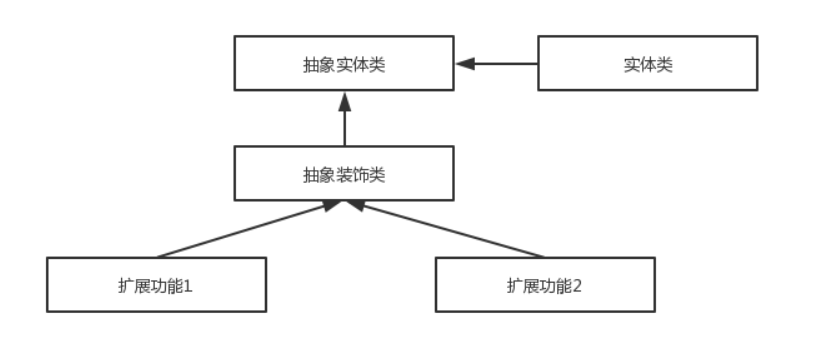

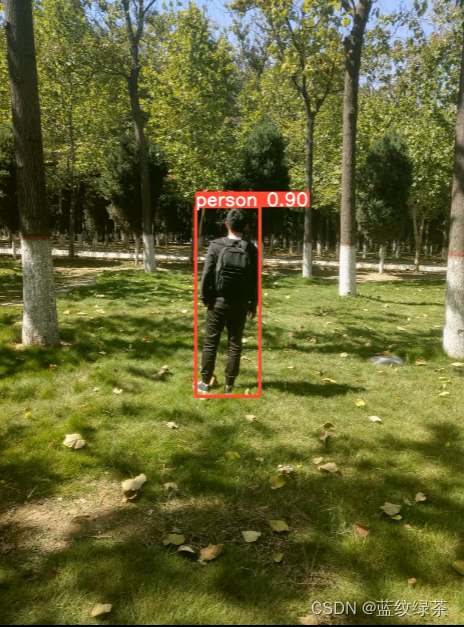
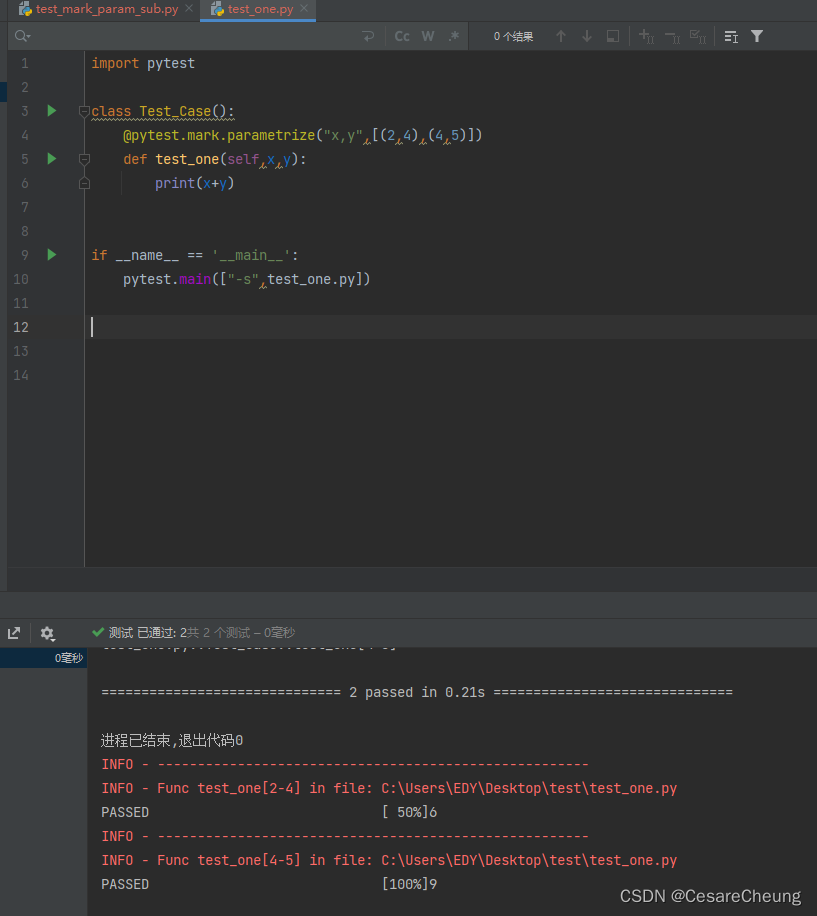

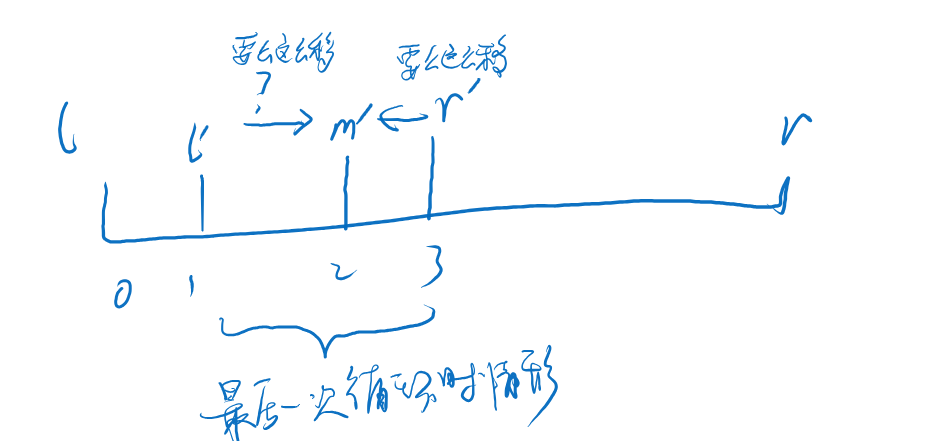
![[代码解读] A ConvNet for the 2020s](https://img-blog.csdnimg.cn/1c61f6366920485d896ccf59710001b8.png)


